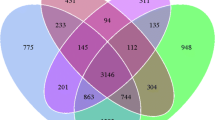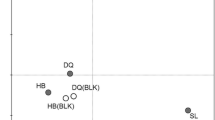Abstract
Bacterial diversity of hydrocarbon-contaminated sites in various regions of Korea was investigated to ascertain the influence of hydrocarbon pollution on bacterial diversity using terminal restriction fragment length polymorphism (T-RFLP) and differential gel gradient electrophoresis. Thirty-two hydrocarbon-contaminated soil samples were collected from seven different geographical locations in Korea. A dendrogram of T-RFLP profiles for the bacterial community structure in soil samples using Ward’s method with Jaccard distance showed that samples from the same location clustered together. Principal components analysis (PCA) and self-organizing maps (SOM) of terminal restriction fragments were also used to characterize the associations among samples. PCA and SOM results also showed that soil bacterial communities were classified according to locations, but not by hydrocarbon pollution level. Moreover, correlation analyses prove a direct correlation between bacterial diversity and meteorological parameters, whereas no significant correlation was observed with hydrocarbon contamination levels. These results suggest that geographical origin, rather than soil contamination level, might be more important in determining the bacterial diversity of crude oil-contaminated soils. Environmental factors, which play a major role in determining natural bacterial diversity which in turn should be enriched for effective bioremediation, should be the central dogma while considering bioremediation of hydrocarbon-contaminated sites.





Similar content being viewed by others
References
Alhoniemi E, Himberg J, Parhankangas J, Vesanto J (2000) Som Toolbox. http://www.cis.hut.fi/projects/somtoolbox/
Baek KH, Yoon BD, Kim BH, Cho DH, Lee IS, Oh HM, Kim HS (2007) Monitoring of microbial diversity and activity during bioremediation of crude oil-contaminated soil with different treatments. J Microbiol Biotechnol 17(1):67–73
Benedek T, Vajna B, Táncsics A, Márialigeti K, Lányi S, Máth I (2013) Remarkable impact of PAHs and TPHs on the richness and diversity of bacterial species in surface soils exposed to long-term hydrocarbon pollution. World J Microbiol Biotechnol 29:1989–2002
Bundy JG, Paton GI, Campbell CD (2002) Microbial communities in different soil types do not converge after diesel contamination. J Appl Microbiol 92(2):276–288. doi:10.1046/j.1365-2672.2002.01528.x
Clescerl LS, Greenberg AE, Eaton AD (1999) Standard methods for the examination of water and wastewater, 20th edn. American Public Health Association, Washington
Dollhopf SL, Hashsham SA, Tiedje JM (2001) Interpreting 16S rDNA T-RFLP data: application of self-organizing maps and principal component analysis to describe community dynamics and convergence. Microb Ecol 42(4):495–505. doi:10.1007/s00248-001-0027-7
Dunbar J, Ticknor LO, Kuske CR (2001) Phylogenetic specificity and reproducibility and new method for analysis of terminal restriction fragment profiles of 16S rRNA genes from bacterial communities. Appl Environ Microbiol 67(1):190–197. doi:10.1128/aem.67.1.190-197.2001
Gadd GM (2010) Metals, minerals and microbes: geomicrobiology and bioremediation. Microbiology 156:609–643
Gillespie IM, Philp JC (2013) Bioremediation, an environmental remediation technology for the bioeconomy. Trends Biotechnol 31(6):329–332
Ji X, Ripp S, Layton A, Sayler G, Debruyn J (2013) Assessing long term effects of bioremediation: soil bacterial communities 14 years after polycyclic aromatic hydrocarbon contamination and introduction of a genetically engineered microorganism. J Bioremed Biodeg 4:2
Juck D, Charles T, Whyte LG, Greer CW (2000) Polyphasic microbial community analysis of petroleum hydrocarbon-contaminated soils from two northern Canadian communities. FEMS Microbiol Ecol 33:241–249
Kim B-H, Baek K-H, Cho D-H, Sung Y, Koh S-C, Ahn C-Y, Oh H-M, Kim H-S (2010) Complete reductive dechlorination of tetrachloroethene to ethene by anaerobic microbial enrichment culture developed from sediment. Biotechnol Lett 32:1829–1835
Kirk J, Zurada J (2004) Topography-enhanced BMU search in self-organizing maps. In: Yin F-L, Wang J, Guo C (eds) Advances in neural networks-ISNN 2004. Springer, Berlin, Heidelberg
Liu W, Luo Y, Teng Y, Li Z, Ma L (2010) Bioremediation of oily sludge contaminated soil by stimulating indigenous microbes. Environ Geochem Health 32:23–29
Maila MP, Randima P, Drønen K, Cloete TE (2006) Soil microbial communities: influence of geographic location and hydrocarbon pollutants. Soil Biol Biochem 38:303–310
McGenity TJ (2014) Hydrocarbon biodegradation in intertidal wetland sediments. Curr Opin Biotechnol 27:46–54
Obayori OS, Adebusoye SA, Adewale AO, Oyetibo GO, Oluyemi OO, Amokun RA, Ilori MO (2009) Differential degradation of crude oil (Bonny Light) by four Pseudomonas strains. J Environ Sci 21:243–248
Palumbo A, Schryver J, Fields M, Bagwell C, Zhou J-Z, Yan T, Liu X, Brandt C (2004) Coupling of functional gene diversity and geochemical data from environmental samples. Appl Environ Microbiol 70:6525–6534
Simpson EH (1949) Measurement of diversity. Nature 163:688
Singh A, Kuhad RC, Ward OP (2009) Biological remediation of soil: an overview of global market and available technologies. In: Singh A, Kuhad RC, Ward, OP (eds) Advances in applied bioremediation. Springer, Berlin
Shannon CE(1948) A mathematical theory of communication. Bell Syst Tech J 27:379–423
Sutton NB, Maphosa F, Morillo JA, Abu Al-Soud W, Langenhoff AAM, Grotenhuis T, Rijnaarts HHM, Smidt H (2013) Impact of long-term diesel contamination on soil microbial community structure. Appl Environ Microbiol 79:619–630
Tan TH, Wong KY, Cheng TK, Heng JT (2003) Coronary normograms and the coronary-aorta index: objective determinants of coronary artery dilatation. Pediatric Cardiol 24:328–335
Tomei MC, Daugulis AJ (2012) Ex situ bioremediation of contaminated soils: an overview of conventional and innovative technologies. Crit Rev Environ Sci Technol 43:2107–2139
Ward JH Jr (1963) Hierarchical grouping to optimize an objective function. J Am Stat Assoc 58:236–244
Acknowledgments
This work was carried out with financial support from the project (KGM 3151312) under the KRIBB Research Initiative Program (www.kribb.re.kr).
Author information
Authors and Affiliations
Corresponding author
Electronic supplementary material
Below is the link to the electronic supplementary material.
Rights and permissions
About this article
Cite this article
Cho, DH., Baek, KH., Ramanan, R. et al. Hydrocarbon pollution does not influence bacterial diversity as much as geographic location: a Korean case study. Int. J. Environ. Sci. Technol. 12, 1889–1898 (2015). https://doi.org/10.1007/s13762-014-0578-z
Received:
Revised:
Accepted:
Published:
Issue Date:
DOI: https://doi.org/10.1007/s13762-014-0578-z




